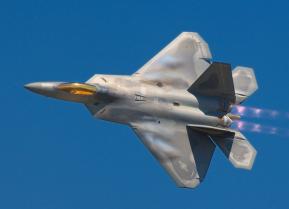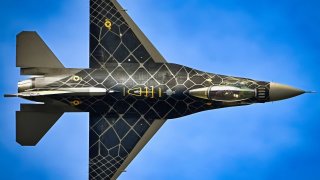F-16 Fighting Falcon: The Best Fighter Jet of All Time?
To date, more than 4,600 aircraft have been built since production of the F-16 Fighting Falcon was approved in 1976. It remains the world's most successful, combat-proven multi-role jet fighter ever.
The F-16 to be Celebrated After a Half a Century of Flight - On January 20, 1974, the YF-16 – the prototype that was the test demonstrator for what would become the General Dynamics F-16 Fighting Falcon – accidentally made its maiden flight during a ground test at Edwards Air Force Base (AFB), California.
Test pilot Phil Oestricher explained that while was conducting the high-speed taxi test, the aircraft lifted off the runway, and rather than risking damage to the prototype plane, Oestricher elected to lift off and go around to come in for a normal landing. The YF-16 made its "official first flight" on February 5.
To mark the 50th anniversary of the F-16's first flights, Edwards AFB will host a celebration on January 25, 2024, that will include aerial demonstrations of the Fighting Falcon. The event is set to include the U.S. Air Force Thunderbirds Winter Training, guest speakers which include retired General Gary "Nordo" North who piloted the first F-16 Air to Air Kill, as well as various F-16 operations veterans.
The Unstoppable F-16: The Best Fighter Jet Ever?
To date, more than 4,600 aircraft have been built since production of the Fighting Falcon was approved in 1976 – and while the U.S. Air Force is no longer acquiring it, Lockheed Martin continues to build the F-16 for foreign customers around the world.
The F-16 fighter remains the world's most successful, combat-proven multi-role jet fighter ever produced.
The fast and agile F-16 Fighting Falcon isn't just one of the top fighters it is also among the most cost-effective. Though it lacks the range and payload of the larger twin-engine F-15 Eagle, it also costs less than half – which is why the fourth-generation F-16 has been in use since the 1970s and will likely keep flying for many more years to come.
Since it first entered service in 1979, the Fight Falcon has engaged in more than 400,000 combat sorties and has more than a combined 19 million flight hours. Moreover, the F-16 has been adapted to complete several missions, including air-to-air fighting, ground attack, and electronic warfare. As a combat fighter, it has proven to be highly maneuverable while its combat radius exceeds that of its potential threats.
Along with the larger F-15 Eagle, the Fighting Falcon was one of the world's first aircraft to withstand higher g-forces than the pilots. These are notable accolades for an aircraft that really began as a technology demonstrator to determine where it was possible to build a versatile fighter that could be cheaper than the F-15.

F-16: Upgraded and Improved
The latest version of the Fighting Falcon is powered by a single engine, either the General Electric F110-GE-129 or Pratt and Whitney F100-PW-229, and while it is a speedy fighter it can pack a serious punch. The F-16 has nine hardpoints for weapons payloads – including one at each wingtip, three under each wing, and one centerline under the fuselage.
It has carried a variety of air-to-air missiles including the Lockheed Martin/Raytheon AIM-9 Sidewinder, Raytheon AMRAAM, Raytheon Sparrow, MBDA (formerly Matra BAE Dynamics) Skyflash and ASRAAM, and the MBDA R550 Magic 2; and in April 2004 it was the first fighter to fire the new-generation AIM-9X Sidewinder. Air-to-surface missiles carried on the F-16 include Maverick, HARM, and Shrike missiles, manufactured by Raytheon, and anti-ship missiles that include the Boeing Harpoon and Kongsberg Penguin.
Lockheed Martin, which acquired General Dynamics' aviation manufacturing business in 1993, delivered the last F-16 from Fort Worth to the Iraqi Air Force in November 2017. The company ended 40 years of F-16 production at its Fort Worth, Texas facility to make room for the new F-35 Lightning II assembly line.
However, in June 2022, it was announced that the aerospace giant would resume production beginning this year at its new factory in Greenville. It is working overtime as Lockheed Martin has a backlog of almost 130 orders from customers around the world.

While the U.S. Air Force bought its last new F-16, a Block 50 model, in 2005, many of its Fighting Falcons have received many of the improvements available in the Block 70, notably the AESA radar. Bulgaria will become the second European country to receive the F-16 Block 70 models – and this month, Lockheed Martin announced that seven are in various stages of production, with the inaugural flight of the first of those aircraft planned for this year. If it is anything like the original aircraft it will likely be eager to take to the skies.

It is clear that the F-16 Fighting Falcon –which took that first and very much unplanned flight nearly 50 years ago this month during the high-speed taxi test – won't have its wings clipped anytime soon.
Author Experience and Expertise: Peter Suciu
Peter Suciu is a Michigan-based writer. He has contributed to more than four dozen magazines, newspapers, and websites with over 3,200 published pieces over a twenty-year career in journalism. He regularly writes about military hardware, firearms history, cybersecurity, politics, and international affairs. Peter is also a Contributing Writer for Forbes and Clearance Jobs. You can follow him on Twitter: @PeterSuciu. You can email the author: [email protected].
All images are Creative Commons.


